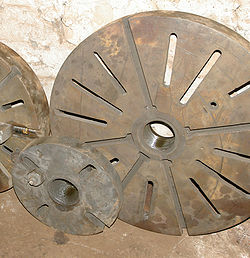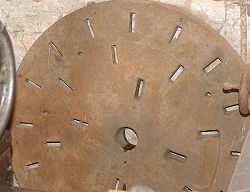
Lathe faceplate
Encyclopedia


Spindle (tool)
In machine tools, a spindle is a rotating axis of the machine, which often has a shaft at its heart. The shaft itself is called a spindle, but also, in shop-floor practice, the word often is used metonymically to refer to the entire rotary unit, including not only the shaft itself, but its bearings...
. The workpiece is then clamped to the faceplate, typically using t-nut
T-nut
A T-nut, also known as a blind nut, is a type of nut used to fasten a wood, particle or composite materials workpiece, leaving a flush surface. It has a long, thin body and a flange at one end, resembling a T in profile...
s in slots in the faceplate, or less commonly threaded holes in the faceplate itself.
The faceplate may be attached to the lathe in several ways: The two most common are a thread and a precision cone arrangement or threaded studs and a circular recess fitting a flange on the end of the spindle. Increasingly common is the camlock
Camlock
A camlock, or 'cam' for short is often used in temporary electrical power production / distribution. It is common in uses where more than 50A is required or 3 phase connections are in use. Camlocks are used to connect large generators or building disconnects to either a distribution panel or...
arrangement where shaped studs and cams replace threaded studs for rapid exchanging of the faceplate with other accessories, such as three or four jaw chucks.
The faceplate was the ancestor of lathe chucks, an arrangement of three or more adjustable 'dogs' bolted to the faceplate providing a primitive chuck arrangement. The smaller plate in the upper photo is specifically a 'dog face' with slots intended to hold a bent tail dog while the work itself was supported on centers. The larger plate to the right simply provides a variety of ways by which work can be bolted or clamped to the plate. The slotted plate on the lower photo accepts wedged holders which can be used to fasten the work to the plate. The plates were expendibles, so it was not unusual as shown in both photos for a machinist to drill additional holes in the plates for attaching work that could not otherwise be attached. While the Dog plates were usually fairly small regardless of the lathe size, the classic face plate is usually matched to the maximum diameter that the lathe will swing.
It may seem that the faceplate is a primitive accessory superseded by precision chucks, but its inherent flexibility (almost any shape can be attached to a faceplate with care and the right fixings) and the possibility of achieving great accuracy by careful setting up make it an essential for the well equipped lathe.
For certain specialist jobs, temporary or special faceplates can be made, perhaps in wood or light alloy, that can be machined or adapted for difficult workholding jobs. One example might be attaching thin sheet metal to a wooden faceplate using woodscrews, allowing the trepanning of holes, with the tool cutting into the sacrificial faceplate material.

